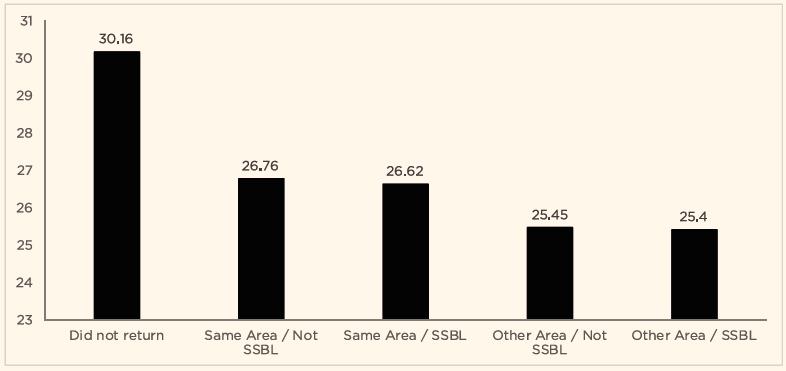Servicios Personalizados
Revista
Articulo
Compartir
Cadernos de Pesquisa
versión impresa ISSN 0100-1574versión On-line ISSN 1980-5314
Cad. Pesqui. vol.50 no.178 São Paulo oct./dic 2020 Epub 23-Nov-2020
https://doi.org/10.1590/198053147158
ARTICLES
THE RETURN TO HIGHER EDUCATION OF DROPOUT STUDENTS IN BRAZIL
IUniversidade Federal da Bahia (Ufba), Salvador (BA), Brazil; tumenas@ufba.br
The number of students in Brazilian higher education has increased dramatically in the recent period. However, evasion has been high and object of study by several researchers. This work brings a new look at the problem, analyzing the return of students who have dropped out from higher education with the microdata of the Higher Education Census from 2009 to 2017. The results show that a large part of the students who dropped out of higher education later returned to higher education and, although they did not return to programs from the same higher education institution, most of them returned to the same area of the originally dropped out program. In addition, programs in the area of Business and Administration are an important destination when students who have dropped out from higher education return, regardless of their area of origin.
Key words: UNIVERSITY EDUCATION; SCHOOL DROPOUT; COURSES; HIGHER EDUCATION CENSUS
O número de alunos no ensino superior brasileiro aumentou muito recentemente. Mas a evasão tem sido alta e objeto de estudo de diversos pesquisadores. Este trabalho analisa microdados do Censo da Educação Superior de 2009 a 2017 sobre a volta aos estudos dos alunos que se evadiram do ensino superior. Os resultados mostram que grande parte dos alunos que se desvincularam voltou para o ensino superior posteriormente, e, apesar de não voltarem para cursos da mesma instituição, a maior parte volta para cursos na mesma área do curso originalmente evadido. Além disso, os cursos da área de Comércio e Administração são um destino importante dos alunos que se desvincularam de cursos superiores, independentemente da área de origem.
Palavras-Chave: ENSINO SUPERIOR; EVASÃO ESCOLAR; CURSOS; CENSO DA EDUCAÇÃO SUPERIOR
El número de alumnos en la educación superior brasileña aumentó muy recientemente. Sin embargo, la evasión viene siendo elevada y es objeto de estudio de diversos investigadores. Este trabajo analiza microdatos del Censo de la Educación Superior de 2009 a 2017 sobre el regreso a los estudios de los alumnos que se evadieron de la educación superior. Los resultados muestran que una gran parte de los alumnos que se desvincularon volvió posteriormente a la educación superior y, a pesar de que no regresaron a cursos de la misma institución, la mayor parte volvió a cursos de la misma área del curso originalmente evadido. Por otra parte, los cursos del área de Comercio y Administración son un destino importante de los alumnos que se desvincularon de cursos superiores, independientemente del área de origen.
Palabras-clave: ENSEÑANZA SUPERIOR; ABANDONO DE ESCUELA; CURSOS; CENSO DE EDUCACIÓN SUPERIOR
Le nombre d’étudiants dans l’enseignement supérieur a beaucoup augumenté ces derniers temps. Pourtant l’abandon est élevé et l’objet d’étude de différents chercheurs. Ce travail analyse des microdonnées du Recensement de l’Enseignement Supérieur (Censo da Educação Superior) de 2009 à 2017 sur la reprise des cours par des étudiants ayant abandonné l’enseignement supérieur. Les résultats montrent qu’une grande partie des étudiants qui avait décroché est retournée ultérieurement á l’université, et bien qu’ils n’aient pas repris les cours dans la même institution, la plupart reprend leurs études dans le même domaine. Par ailleurs, les cours supérieurs de commerce et administration sont une destination importante des étudiants décrochés de l’université indépendamment du domaine d’origine.
Key words: ENSEIGNEMENT UNIVERSITAIRE; ABANDON SCOLAIRE; COURS; RECENSEMENT DE L’ENSEIGNEMENT SUPÉRIEUR
Human capital has become the center of debates on economic development (KAPUR; CROWLEY, 2008). According to the same authors, higher education is fundamental to build human capital, which, in turn, builds the institutions considered indispensable for development. In addition, a strong higher education system is crucial to the success of democracy, contributing to greater social mobility and egalitarianism.
According to Durham (2003), the development of higher education in Brazil has two important characteristics. A late character and an early development of a powerful private education system parallel to the public sector. In Brazil, the first higher education schools were founded in 1808 with the arrival of the Portuguese royal family. The School of Surgery and Anatomy in Salvador, the School of Anatomy and Surgery and the Academia da Guarda Marinha, both in Rio de Janeiro (MARTINS, 2002). According to Martins (2009), in 1968 there was a reform of higher education, modernizing a significant part of universities. Lifetime chairs were abolished with the introduction of departmental regime and the academic career was institutionalized, with the admission and teaching progression based on academic titles. In addition, the reform paved the way for private education structured as educational companies, aimed at meeting the demands of educational consumers.
Brazilian higher education has considerably expanded in recent years, both in public and private higher education institutions (HEIs). According to data from Instituto Nacional de Estudos e Pesquisas Educacionais Anísio Teixeira (Inep) (BRASIL, 2019), the number of students enrolled in higher education went from 5.9 million in 2009 to 8.2 million in 2017. However, the number of graduating students in higher education remains relatively low, going from 959 thousand in 2009 to 1.1 million in 2018. Figure 1 shows the number of students enrolled and the number of graduating students in higher education each year.
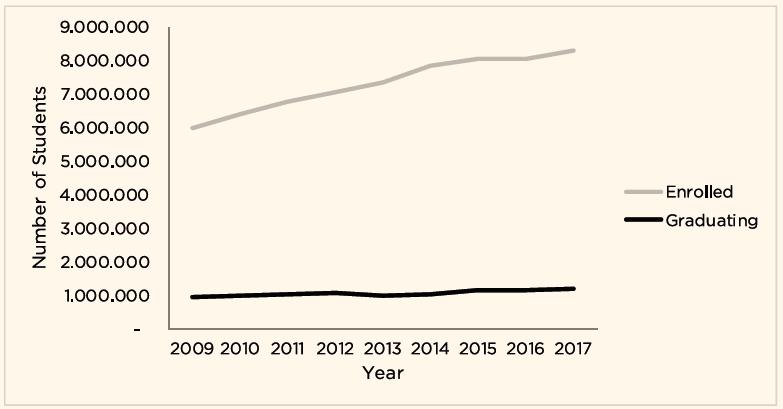
Source: Own elaboration based on data from Higher Education Census (BRASIL, 2019).
FIGURE 1 STUDENTS ENROLLED AND GRADUATING IN BRAZILIAN HIGHER EDUCATION
The data show that the number of graduating students is much lower than the number of students enrolled in higher education, and this is due to dropout. According to Silva Filho et al. (2007), dropout is a social, academic and economic waste, affecting both HEIs and students.
Dropout in higher education has been the object of studies by several authors in Brazil. Evasion studies in higher education can be categorized into three groups. In the first group, Silva Filho et al. (2007) established a method of estimating the dropout rate of programs with the number of enrolled students, number of graduating students and the number of freshmen in each year. This approach was necessary when data from programs and institutions were made available summarized by Inep, without detailed information on students. In the second group, there are studies with methodologies using the internal data from the institutions to calculate dropout and try to understand the important factors for dropping out. According to Silva (2013), the studies in this group, in general, apply questionnaires or interview dropout students to find out the reasons for dropping out. As examples of studies in this group, there are Cunha, Tunes and Silva (2001), Braga, Peixoto and Bogutchi (2003), Campello and Lins (2008), Mercuri and Polydoro (2003), Andriola, Andriola and Moura (2006), Andrade et al. (2007) and Polydoro et al. (2005). The results found in these studies indicate that dropout originates from several factors, such as low level of commitment to the program, lack of family support, low participation in academic activities, poor facilities, poor school performance and lack of career prospects, and these factors vary between the different HEIs (SILVA, 2013).
In addition to traditional studies on dropout, some authors have started to use advanced quantitative methods to understand the problem of dropout in higher education. Silva (2013) uses sophisticated statistical methods, like Survival Analysis, and Tontini and Walter (2014) use artificial neural networks and cluster analysis to assess the phenomenon of dropout in higher education.
Santos Junior and Real (2017) surveyed the scientific literature, theses and dissertations on higher education evasion and found that studies related to the causes and also to the evasion control strategies in a specific program or institution are more prominent.
In the evolution of the research on school dropout in Brazilian higher education, we have a change of focus. In the first group of studies, the focus is on the general data available from the program / HEI. In the second group of studies, the focus is on the data of dropout students within specific HEIs.
However, a student’s dropout from a program may not necessarily imply that the student has dropped out of higher education. Maybe he or she has started studying at another HEI. This may be due to simple factors such as a change of city, or to more complex factors, such as changes in student interest due to a very early professional career choice, unrealistic expectations with the program, among others (BARDAGI; HUTZ, 2009).
Santos Junior and Real (2017) recalls that, in the 1990s, discussions about higher education dropout separated three types of dropout: “Program dropout”, which occurs when the student has a temporary dropout to another program in the same institution; “Institution dropout”, when the student enrolls in another HEI; and “Higher education system dropout”, when the student leaves higher education.
This article brings new information to the analysis of the dropout problem in higher education, by analyzing the situation of students who, after leaving a higher education program, return to higher education. Although there are already studies on dropout in higher education, there are not, both in national literature and in international literature, studies that evaluate the profile of students who return to study after dropping out of a higher education program. To bridge this gap, this study presents the following central research question: How many returning students are there and who are the students who return? The importance of this study lies in the fact that, by identifying students who return to study after dropping out, it is possible to better understand the problem of dropout in higher education and develop strategies to reduce it. Specifically, this study aims to: a) quantify the number of students who return to higher education after dropout and their representativeness in Brazilian higher education; b) quantify the number of students who return to study in the same program, whether in the same HEI or not; c) verify the transition of students across programs of different knowledge areas in higher education.
The article is divided into four sections, the first being this introduction. The second section describes the database and methodology used. In the third section there are the results and analysis; and, in the fourth section, there are the final considerations and the discussion about the limitations of the study and possible future research.
DATABASE AND METHODOLOGY
The database for this article is the microdata from the Higher Education Census (BRASIL, 2019) released by Inep. This census is carried out annually and considers all Brazilian higher education institutions and provides information about their students, teachers and programs. Detailed information on all students became available since the 2009 census. Since then, students have a unique identification code (CO_ALUNO), which makes it possible to monitor their progress in any census and in any HEI that the student is in. However, since the 2018 census the unique identification code changed its encoding to ID_ALUNO, to increase the protection of personal data present in the databases. This change forbids a direct comparison of students from censuses prior to 2018. For this reason, the censuses to be considered in this article will be from 2009 to 2017.
Within the census, the variable ‘CO_ALUNO_SITUAÇÃO’ will be used to find students who have dropped out from higher education and later returned. The variable “CO_ALUNO_SITUAÇÃO” has the following student states: “Enrolled”, “Locked”, “Unlinked”, “Transferred to another program of the same HEI”, “Graduated”, “Deceased”. The student will be considered as dropped out if “CO_ALUNO_SITUAÇÃO” is “Unlinked”.
The analysis is based on flagging, for each census from 2009 to 2017, students who have the variable “CO_ALUNO_SITUAÇÃO” indicating that they are “Unlinked” and look for those students in later censuses to find those who have the variable “CO_ALUNO_SITUAÇÃO” as “Enrolled”. The analysis will also look in the same census whether the student has started a program in another HEI in the same year. From the identification of these students, a descriptive analysis of the characteristics of the students will be performed with the variables available in the census.
ANALYSIS AND RESULTS
The first step is to assess the situation, up to the most recent information, of students in all censuses. Figure 2 shows the situation, up to the 2017 census data, of incoming students for each year, from 2009 to 2017. The analysis is made using the variable “CO_ALUNO_SITUAÇÃO”, which has six possible states: Enrolled, Locked, Unlinked, Transferred to another program in the HEI, Graduated and Deceased. For each year, for the students who started a program at an HEI, the proportion of the last available status of the variable “CO_ALUNO_SITUAÇÃO” in subsequent censuses.

Source: Own elaboration based on data from Higher Education Census (BRASIL, 2019).
FIGURE 2 STUDENTS STATUS, BY ADMISSION YEAR, UP TO THE 2017 CENSUS
The proportion of “Enrolled” students ranges from 7.52% of the students who entered in 2009 to 4.38% of the students who entered in 2010. The proportion of “Locked” students remains lower than 10% for almost every year, except for 2016, which is 11.39%. Most students who entered in the years 2009 to 2014 are “Unlinked”. For those students who entered in the years 2015 and 2016, the proportion of “Unlinked” is still greater than 30%. In 2017, the proportion of “Unlinked” students is 15.9%, that is, students who dropout from the program in the same year of admission. The proportion of students transferred to other programs in the same HEI is approximately 3%. The proportion of students graduated per year has the highest value for students from 2009, with 42.13%. The proportion of graduating students decreases for most recent years (since less time has elapsed). The proportion of students who left due to Death is not greater than 0.05% in any year.
The focus of this work is the students who, once dropped out from higher education, return to study. In order to accomplish this goal, the basis of analysis will be the “Unlinked” students and, later in other censuses, appear with the “Enrolled” status. Figure 3 shows the number, for each census, of students who dropped out and, afterwards in other censuses, were once again enrolled in a higher education program, whether in the same HEI or not.
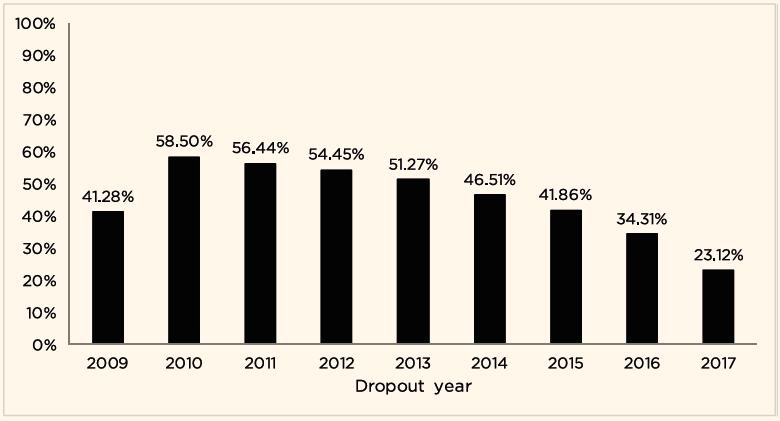
Source: Own elaboration based on data from Higher Education Census (BRASIL, 2019).
FIGURE 3 PERCENTAGE OF DROPOUT STUDENTS WHO RETURNED TO STUDY UNTIL THE 2017 CENSUS
We can see that, except for 2009, the proportion of students who dropped out of a higher education program and later re-joined a higher education program tends to be greater than 50%. Of the students who dropped out in 2010, 58.50% returned to study at some point until the year 2017. On the other hand, of the students who dropped out in 2016, 34.31% returned to study. 23.12% of students who dropped out in 2017 are already enrolled in another higher education program in the same year.
The data of students who return to study after dropping out allow to calculate the average time between the year the student left a higher education program and the year the student returns to higher education (whether to the same program or not) and to calculate the proportion of students who return in the same year, after one year, after two years, and so forth. The shortest time possible is 0 (zero) year, representing students who have dropped out and joined another program within the same census, and the longest available time is 8 years, referring to students who dropped out in the 2009 census and returned to study only in the 2017 census. In Figure 4 we have, for each available period of time, the proportion of dropout students who returned.
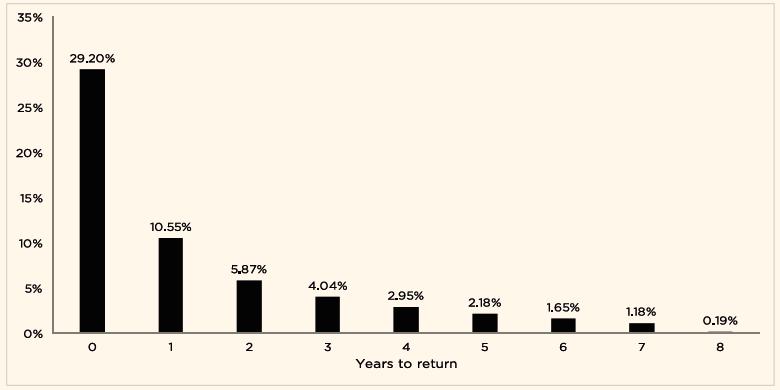
Source: Own elaboration based on data from Higher Education Census (BRASIL, 2019).
FIGURE 4 PERCENTAGE OF DROPOUT STUDENTS WHO RETURN TO STUDY
29.20% of the students who return to study do so in the same year that they left the higher education program (Year 0). The proportion of students who return to study after one year (Year 1) is 10.55%. The proportion decreases over time, with only 0.19% of students returning to study doing so after 8 years. The average time to return is 0.77 years. That is, dropout students who return to study do so, on average, in less than 1 year after dropping out.
The next step is to evaluate the characteristics of the programs that students return to study. Figure 5 shows the proportion of students who returned to study in a program in the same city and the proportion of students who returned to study in a program in another city.
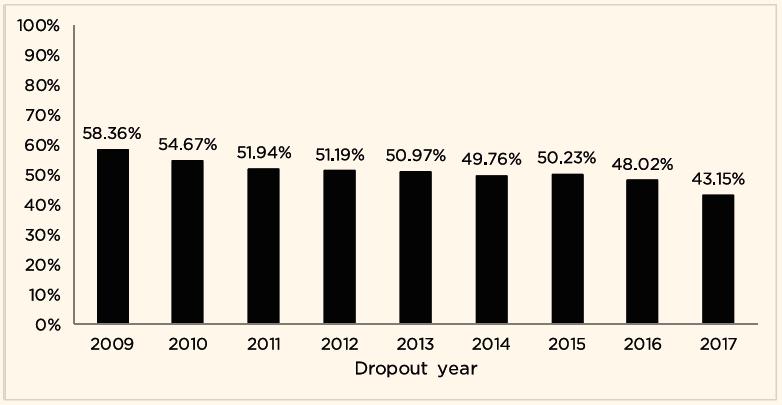
Source: Own elaboration based on data from Higher Education Census (BRASIL, 2019).
FIGURE 5 PROPORTION OF DROPOUT STUDENTS WHO RETURNED TO STUDY IN THE SAME CITY
The proportion of students who returned to programs in the same city fluctuates around 50%, which indicates a geographical factor in the reasons for dropout. A possible explanation could be that students in metropolitan regions may go to programs closer to their homes or work. However, further investigation of the geographic issue is outside the scope of this article.
In addition to the geographic issue, it is important to assess whether the student returns, after dropping out, to other programs in the same HEI. Figure 6 shows the proportion of students who returned to programs at the same HEI.
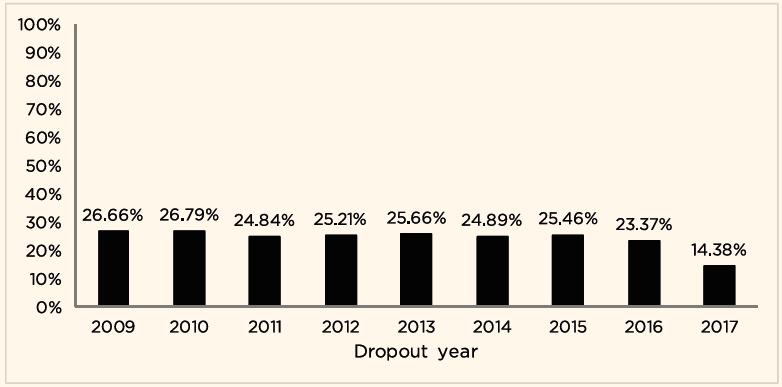
Source: Own elaboration based on data from Higher Education Census (BRASIL, 2019).
FIGURE 6 PROPORTION OF DROPOUT STUDENTS WHO RETURNED TO PROGRAMS AT THE SAME HEI
In the same way that the proportion of students returning to higher education programs in the same city is stable, the proportion of students returning to a program in the same HEI is stable in the period observed, approximately 25%. In addition, this proportion is greater than the proportion of students whose state in the variable “CO_SITUACAO_ALUNO” is “Transferred to another program in the HEI”, which may be an indicative that the student took the entrance exam again to enter programs that are not possible to transfer.
In addition to assessing whether students return to programs in the same HEI, it is possible to assess whether students return to HEIs in the same administrative category or not. The Higher Education Census classifies HEIs in the following administrative categories: Public Federal, Public State, Public Municipal, Private for Profit, Private Non-Profit, Private Religious and Special. Table 1 shows the proportions of students who return to study from all administrative categories to all administrative categories.
TABLE 1 PERCENTAGE OF DROPOUT STUDENTS WHO RETURNED BY HEI CATEGORy
| New HEI | ||||||||
|---|---|---|---|---|---|---|---|---|
| Public Federal | Public State | Public Municipal | Private For Profit | Private Non Profit | Private Religious | Special | ||
| Original HEI | Public Federal | 28.81 | 12.91 | 0.95 | 43.45 | 10.75 | 3.14 | - |
| Public State | 32.21 | 9.48 | 1.09 | 45.46 | 8.89 | 2.87 | - | |
| Public Municipal | 10.65 | 6.26 | 2.69 | 59.87 | 17.24 | 3.29 | - | |
| Private For Profit | 8.76 | 4.06 | 0.89 | 71.00 | 12.22 | 3.02 | 0.05 | |
| Private Non Profit | 12.15 | 4.26 | 1.35 | 61.87 | 16.62 | 3.74 | - | |
| Private Religious | 13.07 | 5.96 | 0.96 | 57.77 | 16.49 | 5.75 | - | |
| Special | 16.73 | 6.26 | - | 55.78 | 21.22 | - | - | |
Source: Own elaboration based on data from Higher Education Census (BRASIL, 2019).
In each row of the table we have the administrative category of the HEI that the student has dropped out from, and in each column, we have the administrative category of the HEI that the student has returned to study. For example, in the first line we have students who have dropped out from programs of Public Federal HEIs. From these students, 28.81% returned to programs offered at Public Federal HEIs and 12.91% to programs offered at Public State HEIs. From those who studied at Federal Public HEIs and State Public HEIs, approximately 40% return to programs offered at HEIs of these two administrative categories. Most returning students from Private for Profit HEIs do so in programs in Private for Profit HEIs (71%). For students from Private Non-Profit HEIs and Private Religious HEIs, the percentage who return to programs at Private for Profit HEIs is lower (61.87% and 57.77%, respectively).
The next question is whether the programs that the students return to are from the same knowledge area. Programs are classified in the Higher Education Census into nine general areas, defined by the OECD. The areas are: 0- Basic Area, 1- Education, 2- Humanities and Arts, 3- Social Sciences, Business and Law, 4- Natural Sciences, Mathematics and Computing, 5- Engineering, Manufacturing and Construction, 6- Agriculture and Veterinary, 7 - Health and Welfare and 8- Services. Figure 7 shows the proportion of students who returned to programs in the same area.
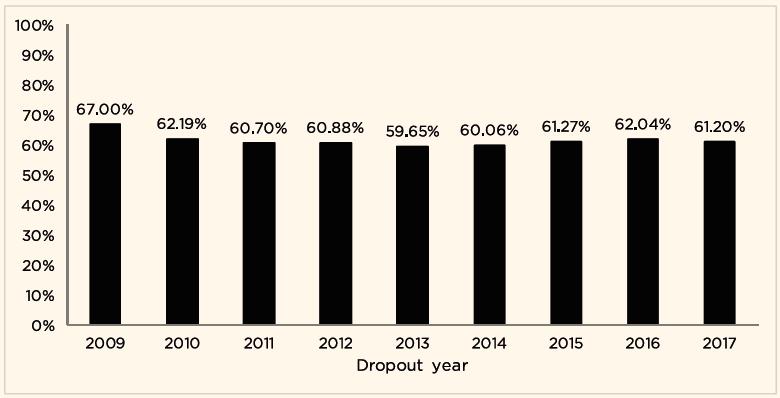
Source: Own elaboration based on data from Higher Education Census (BRASIL, 2019).
FIGURE 7 PROPORTION OF STUDENTS WHO RETURNED TO PROGRAMS IN THE SAME AREA
Most returning students, approximately 60%, return to programs in the same area. However, a relevant portion of students return to programs in a different area. In order to assess the movement of students across areas, we have, in Table 2, a matrix of origin and destination of the returning students. In each row of the table is the area of the student’s original program and in each column is the area of the program the student returned to. In each combination of row and column is the proportion of students in this situation.
TABLE 2 PERCENTAGE OF DROPOUT STUDENTS WHO RETURNED BY AREA
| New Area | ||||||||||
|---|---|---|---|---|---|---|---|---|---|---|
| Basic Area | Education | Arts and Humanities | Social Sciences, Business and Law | Natural sciences, mathematics and computation | Engineering, manufacturing and construction | Agriculture and veterinary | Health and welfare | Services | ||
| Original Area | Basic Area | 5.53 | 11.81 | 7.41 | 21.96 | 21.81 | 20.44 | 1.25 | 8.53 | 1.26 |
| Education | 0.15 | 55.04 | 2.70 | 20.37 | 4.68 | 4.86 | 1.26 | 9.21 | 1.73 | |
| Arts and humanities | 0.44 | 16.52 | 30.90 | 30.84 | 5.08 | 7.40 | 1.07 | 5.36 | 2.37 | |
| Social Sciences, Business and Law | 0.06 | 7.37 | 1.92 | 74.40 | 2.90 | 4.78 | 1.02 | 5.69 | 1.86 | |
| Natural sciences, mathematics and computation | 0.32 | 9.70 | 2.32 | 24.56 | 40.95 | w11.61 | 1.74 | 7.17 | 1.63 | |
| Engineering, manufacturing and construction | 0.20 | 4.57 | 1.66 | 19.87 | 5.90 | 59.90 | 1.71 | 4.69 | 1.51 | |
| Agriculture and veterinary | 0.16 | 8.17 | 1.31 | 21.10 | 4.87 | 9.46 | 43.64 | 8.88 | 2.40 | |
| Health and welfare | 0.07 | 9.88 | 1.04 | 18.50 | 2.46 | 3.28 | 1.20 | 61.59 | 1.99 | |
| Services | 0.08 | 12.50 | 2.71 | 33.48 | 4.54 | 7.89 | 2.43 | 10.49 | 25.89 | |
Source: Own elaboration based on data from Higher Education Census (BRASIL, 2019).
Only 5.53% of the returning students from the Basic Area remained in the area. Most returned to programs in Social Sciences, Business and Law (21.96%), Sciences, Mathematics and Computing (21.81%) and Engineering, Manufacturing and Construction (20.44%). Most Education students return to programs in the area of Education (55.04%) and programs in the area of Social Sciences, Business and Law (20.37%). Humanities and Arts students return to programs in the Humanities and Arts area (30.90%) and Social Sciences, Business and Law (30.84%) followed by the Education area (16.52%). Social Science, Business and Law students have the highest rate of return in programs of the same area, with 74.40%, and no other knowledge area with more than 10%. 40.95% of the returning Natural Science, Mathematics and Computer students remained in the area, followed by 24.56% who went to the Social Sciences, Business and Law area and by 11.61% who went to Engineering, Manufacturing and Construction. Returning Students in the areas of Engineering, Manufacturing and Construction, Agriculture and Veterinary and Health and Welfare follow the same pattern. Most of them return to programs in the same area, followed by Social Sciences, Business and Law. Most of the returning students in the Services area go to programs of Social Sciences, Business and Law area (33.48%), followed by programs in the Services area (25.89%).
For all areas, the proportion of students returning to Social Sciences, Business and Law programs is relevant. To further detail the transition across programs, in Table 3 there are the proportions in each specific area of “Social Sciences, Business and Law” area.
TABLE 3 PERCENTAGE OF DROPOUT STUDENTS WHO RETURNED IN “SOCIAL SCIENCES, BUSINESS AND LAW” AREA
| New Area | |||||
|---|---|---|---|---|---|
| Journalism | Business and Administration | Law | Social and Behavioral Sciences | ||
| Original Area | Basic Area | 1.67 | 7.57 | 5.62 | 7.10 |
| Education | 0.70 | 12.52 | 4.66 | 2.49 | |
| Arts and humanities | 2.82 | 16.90 | 6.54 | 4.58 | |
| Social and Behavioral Sciences | 1.28 | 19.23 | 7.56 | 41.18 | |
| Journalism | 31.31 | 22.60 | 8.07 | 4.75 | |
| Business and Administration | 0.76 | 64.06 | 5.83 | 2.47 | |
| Law | 0.65 | 12.37 | 65.68 | 2.20 | |
| Natural sciences, mathematics and computation | 0.64 | 17.45 | 4.46 | 2.01 | |
| Engineering, manufacturing and construction | 0.36 | 14.05 | 3.91 | 1.55 | |
| Agriculture and veterinary | 0.59 | 12.45 | 6.01 | 2.05 | |
| Health and welfare | 0.38 | 11.61 | 4.39 | 2.12 | |
| Services | 1.02 | 23.20 | 6.24 | 3.02 | |
Source: Own elaboration based on data from Higher Education Census (BRASIL, 2019).
Except for students in the “Social and Behavioral Sciences” programs, most students who move to the “Social Sciences, Business and Law” area, do so in programs in Business and Administration.
Among students who dropped out from higher education programs, we can potentially have five different profiles based on whether the program is in the same area or not and whether the program is in the area of “Social Sciences, Business and Law” (SSBL). In figures 8, 9 and 10 there are the percentage of women, the average age and the average enrollment time in the program that was abandoned, respectively, for each of the five groups.
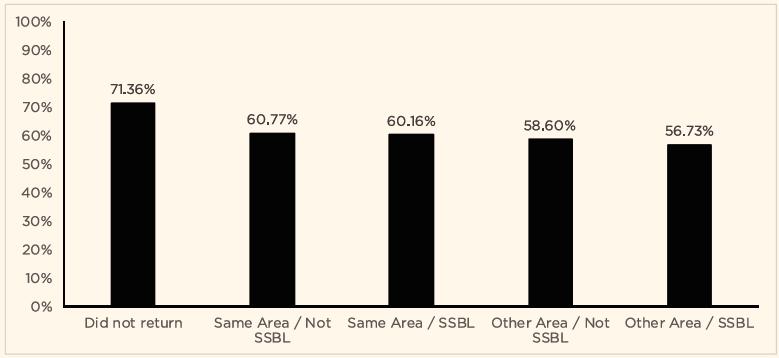
Source: Own elaboration based on data from Higher Education Census.
FIGURE 8 INDICATORS FOR THE GROUPS OF DROPOUT STUDENTS
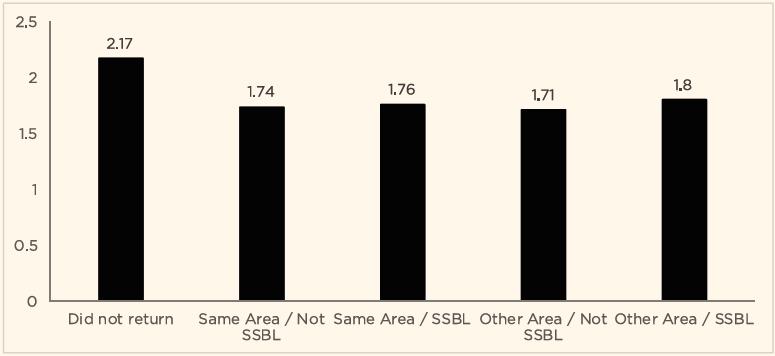
Source: Own elaboration based on data from Higher Education Census (BRASIL, 2019).
FIGURE 10 AVERAGE ENROLLMENT TIME IN THE PROGRAM THAT WAS ABANDONED
The proportion of women seems to be higher in the group of students who did not return to study. For the analyzed period, the average age of the students who did not return to study is higher than the average age in the other groups. The same occurs with the average enrollment time, where the group of students who did not return has a higher average than the other groups. For the two groups of students who returned to programs in the same area (‘Returned to the same Area/Not SSBL’ and ‘Returned to the same Area/SSBL), the proportions of women are similar, approximately 60%, as well as the average age, approximately 26 years, and the enrollment time, 1.7 years. In the two groups of students who returned to study in another area (‘Returned to another Area / Not SSBL and ‘Returned to another Area / SSBL’) the average age is similar, approximately 25 years, while the proportion of women and enrollment time is slightly different. The average enrollment time is longer for students who have not returned. In the groups of students who have returned, there is no visible difference between the average enrollment time. The average age seems to have a decreasing trend, starting from the group of students who have not returned to study (highest average age), passing through the groups of students who returned to programs in the same area to the groups of students who returned for programs in other areas (lower average age). The same occurs with the proportion of women, with the highest proportion in the group of students who did not return to study, passing through the group of students who returned to programs in the same area, until reaching the lowest proportion of women in the groups of students who returned to study in other areas.
FINAL CONSIDERATIONS
Student evasion in higher education is an important problem in Brazil. This paper helps the search for solutions by evaluating the return to studies of dropout students and brings three main contributions to the debate. The first contribution of this paper is the information on the number of students who return to study after dropping out. More than 50% of students dropping out of higher education return to study at some point in the future. The second contribution is the information that those who return to studies do so, on average, in less than one year after dropping out. The third contribution focuses on the relationships across programs sought after evasion. Data analysis showed that, although the percentage of students returning to programs in the same area is high, the percentage of students returning to programs in the same HEI is low, in addition to the considerable number of students who, regardless of the original area, choose programs in the Business and Administration area when they return.
This new information raises the following question: the choice of programs in the “Social Sciences, Business and Law” area, more specifically “Business and Administration”, by dropouts who returned to study is due to a need for quick insertion in the labor market or is due to a possible difference in the level of study requirements? According to Oliveira and Sauerbronn (2007), business and administration programs are, in most cases, composed of students who want a university degree, without having a real interest in the profession. In the words of Bertero (2007, p. 6, own translation), business and administration programs have been “more of a general education program than a program marked by rigorous content”. Outside Brazil, this view is also shared by Neem (2019), for whom the diploma in the business area is for students who want a university degree without having a university education. In the United States, business students spend less time studying than anyone else on campus, and spend less time reading and writing than students on other programs (SELLINGO, 2017). In Brazil, teaching in the areas of business and administration have already been separated from higher education. As an example, in the creation of the Ministry of Education and Public Health (MES) in the 1930s, the first minister, Francisco Campos, implemented educational reforms and organized secondary, higher and commercial education. (FÁVERO, 2006). Commercial education has succumbed due to the expansion of higher education business and administration programs, which are more attractive in terms of social prestige for graduates (PERES, 2007).
The results presented here also bring the need to expand the research scope on dropout in higher education. An immediate practical implication is the need to separate students who dropout from higher education in those who are just changing programs and those who are leaving higher education. A separation that was already considered by researchers in the 90s (SANTOS JUNIOR; REAL, 2017). This separation opens new paths both in surveys to understand the reasons for evasion and in the actions to be taken by HEIs to minimize evasion. A possible option to minimize dropout would be to design options to facilitate the change of programs. Another possible option is the interdisciplinary bachelor’s degrees (BI) that have appeared in Brazilian universities. According to Teixeira, Coelho and Rocha (2013, p. 1.636, own translation), the interdisciplinary baccalaureate is “a first cycle in the process of higher education, in a non-professional character, constituting a preparatory stage for the continuation of professional and academic training”. However, these alternatives can come up against both the traditional structure of programs at Brazilian universities, where the design of the credits, most of the time, focuses on training for specific careers, as well as they can bump into the expectation of students to already enter a defined career.
Despite the contributions, this research has limitations. Among the limitations we have the use of only one public database (the microdata from the Higher Education Census) and the results that are presented for the entire student population, without detailing the regional characteristics and specific contexts of different HEIs and knowledge areas. Therefore, it is necessary to carry out further research to understand the determinants of the destination programs of students who dropped out from higher education and also to bring in other information, such as program quality, tuition, professional perspectives, regional factors, among others. In addition, other new questions are brought up, such as: what is the reason for the difference in the proportion of women between the students who return to study and the students who do not return to study? What is the role of age in the relationship between students who return to study and students who do not return to study?, as well as between students who return to study in programs in the same area and students who return to study in programs in another area?
In summary, the results found here open new paths for the study of dropout in higher education, both by the institutions responsible for educational policies and by researchers on the subject, an extremely relevant problem faced by HEIs.
REFERÊNCIAS
ANDRADE, Selma Maffei de; NUNES, Elisabete de Fátima Polo de A.; JÚNIOR, Luiz C.; HADDAD, Maria do Carmo L.; SOUZA, Nadia Aparecida de; GARANHANI, Maria Lúcia. Análise da evasão de alunos dos cursos de profissionalização da área de enfermagem no Paraná. Ciência, Cuidado e Saúde, Maringá, PR, v. 6, n. 4, p. 433-440, 2007. https://doi.org/10.4025/cienccuidsaude.v6i4.3869 [ Links ]
ANDRIOLA, Wagner Bandeira; ANDRIOLA, Cristiany Gomes; MOURA, Cristiane Pascoal. O fenômeno da evasão discente dos cursos de graduação da Universidade Federal do Ceará (UFC): proposição de modelo causal. I Reunião da Associação Brasileira de Avaliação Educacional. 2006. [ Links ]
BARDAGI, Marucia Patta; HUTZ, Cláudio Simon. “Não havia outra saída”: percepções de alunos evadidos sobre o abandono do curso superior. Psico-USF, Itatiba, SP, v. 14, n. 1, p. 95-105, jan./abr. 2009. [ Links ]
BERTERO, Carlos Osmar. A docência numa universidade em mudança. Cadernos Ebape.BR, Rio de Janeiro, v. 5, n. especial, p. 1-11, jan. 2007. [ Links ]
BRAGA, Mauro Mendes; PEIXOTO, Maria do Carmo, L.; BOGUTCHI, Tânia F. A evasão no ensino superior brasileiro: o caso da UFMG. Avaliação: Revista da Avaliação da Educação Superior, Sorocaba, SP, v. 8, n. 3, p. 161-189, mar. 2003. [ Links ]
BRASIL. Instituto Nacional de Estudos e Pesquisas Educacionais Anísio Teixeira. Censo da Educação Superior. Brasília, DF: Inep, 2019. Disponível em: http://portal.inep.gov.br/web/guest/microdados. Acesso em: 21 nov. 2019. [ Links ]
CAMPELLO, Antonio de Vasconcellos Carneiro; LINS, Luciano Nadler. Metodologia de análise e tratamento da evasão e retenção em cursos de graduação de instituições federais de ensino superior. In: ENCONTRO NACIONAL DE ENGENHARIA DE PRODUÇÃO, 28., 2008, Rio de Janeiro. Anais [...]. Rio de Janeiro: Associação Brasileira de Engenharia de Produção, 2008. Disponível em: http://www.abepro.org.br/biblioteca/ enegep2008_TN_STO_078_545_11614.pdf. Acesso em: 20 jan. 2020. [ Links ]
CUNHA, Aparecida Miranda; TUNES, Elizabeth; SILVA, Roberto Ribeiro da. Evasão do curso de química da Universidade de Brasília: a interpretação do aluno evadido. Química Nova, São Paulo, v. 24, n. 2, p. 262-280, mar./abr. 2001. [ Links ]
DURHAM, Eunice Ribeiro. O ensino superior no Brasil: público e privado. São Paulo: Nupes-USP, 2003. [ Links ]
FÁVERO, Maria de Lourdes de Albuquerque. A universidade no Brasil: das origens à reforma universitária de 1968. Educar em Revista, Curitiba, n. 28, p. 17-36, 2006. [ Links ]
KAPUR, Devesh; CROWLEY, Megan. Beyond the ABCs: higher education and developing countries. s.l.: Center for Global Development Working Paper, 2008. [ Links ]
MARTINS, Antonio Carlos Pereira. Ensino superior no Brasil: da descoberta aos dias atuais. Acta Cirúrgica Brasileira, São Paulo, v. 17, Supl. 3, p. 4-6, 2002. [ Links ]
MARTINS, Carlos Benedito. A reforma universitária de 1968 e a abertura para o ensino superior privado no Brasil. Educação & sociedade, Campinas, SP, v. 30, n. 106, p. 15-35, jan./abr. 2009. [ Links ]
MERCURI, Elizabeth; POLYDORO, Soely Aparecida J. O compromisso com o curso no processo de permanência/evasão no ensino superior: algumas contribuições. In: MERCURI, Elizabeth; POLYDORO, Soely Aparecida J. (org.). Estudante universitário: características e experiências de formação. Taubaté: Cabral Editora e Livraria Universitária, 2003. p. 188-219. [ Links ]
NEEM, Johann. Abolish the Business Major! Anti-intellectual degree programs have no place in colleges. The Chronicle of Higher Education, August 13, 2019. Disponível em: https://www.chronicle.com/interactives/2019-08-13-abolish-the-business-major. Acesso em: 21 jun. 2020. [ Links ]
OLIVEIRA, Fátima Bayma de; SAUERBRONN, Fernanda Filgueiras. Trajetória, desafios e tendências no ensino superior de administração e administração pública no Brasil: uma breve contribuição. Revista de Administração Pública, Rio de Janeiro, v. 41, n. especial, p. 149-170, 2007. [ Links ]
PERES, Fernando Antonio. Alguns apontamentos sobre o ensino comercial no Brasil. In: ENCONTRO DE ESTUDOS E PESQUISAS EM HISTÓRIA, TRABALHO E EDUCAÇÃO NO BRASIL, 2007, Campinas. Anais [...] Campinas, SP: Unicamp, 2007. Disponível em: http://www.histedbr.fae.unicamp.br/acer_histedbr/encontro/encontro1/trab_pdf/t_fernando%20antonio%20peres.pdf. Acesso em: 21 jun. 2020. [ Links ]
POLYDORO, Soely Aparecida J.; SANTOS, Acácia Aparecida Angeli; VENDRAMINI, Claudete Maria Medeiros; SBARDELINI, Elizabeth Teresa Brunini; SERPA, Maria Nasaré Fonseca; NATÁRIO, Elisete Gomes. Percepção de estudantes evadidos sobre sua experiência no ensino superior. In: JOLY, M. C. R. A.; SANTOS, A. A. A.; SISTO, F. F. (org.). Questões do cotidiano universitário. São Paulo: Casa do Psicólogo, 2005. p. 179-199. [ Links ]
SANTOS JUNIOR, José da Silva; REAL, Giselle Cristina Martins. A evasão na educação superior: o estado da arte das pesquisas no Brasil a partir de 1990. Avaliação: Revista da Avaliação da Educação Superior, Sorocaba, SP, v. 22, n. 2, p. 385-402, 2017. [ Links ]
SELLINGO, Jeffrey J. Business is the most popular college major, but that doesn’t mean it’s a good choice. Washington Post, 28 Jan. 2017. Disponível em: https://www.washingtonpost.com/news/grade-point/wp/2017/01/28/business-is-the-most-popular-college-major-but-that-doesnt-mean-its-a-good-choice/. Acesso em: 22 jun. 2020. [ Links ]
SILVA FILHO, Roberto Leal Lobo; MOTEJUNAS, Paulo Roberto; HIPÓLITO, Oscar; MELO LOBO, Maria Beatriz de Carvalho. A evasão no ensino superior brasileiro. Cadernos de Pesquisa, São Paulo, v. 37, n. 132, p. 641-659, set./dez. 2007. [ Links ]
SILVA, Glauco Peres da. Análise de evasão no ensino superior: uma proposta de diagnóstico de seus determinantes. Avaliação: Revista da Avaliação da Educação Superior, Sorocaba, SP, v. 18, n. 2, p. 311-333, jul. 2013. [ Links ]
TEIXEIRA, Carmen Fontes de Souza; COELHO, Maria Thereza Ávila Dantas; ROCHA, Marcelo Nunes Dourado. Bacharelado interdisciplinar: uma proposta inovadora na educação superior em saúde no Brasil. Ciência & Saúde Coletiva, Rio de Janeiro, v. 18, p. 1635-1646, jun. 2013. [ Links ]
TONTINI, Gérson; WALTER, Silvana Anita. Pode-se identificar a propensão e reduzir a evasão de alunos? Ações estratégicas e resultados táticos para instituições de ensino superior. Avaliação: Revista da Avaliação da Educação Superior, Sorocaba, SP, v. 19, n. 1, p. 89-110, mar. 2014. [ Links ]
Received: February 23, 2020; Accepted: July 03, 2020











 texto en
texto en 


